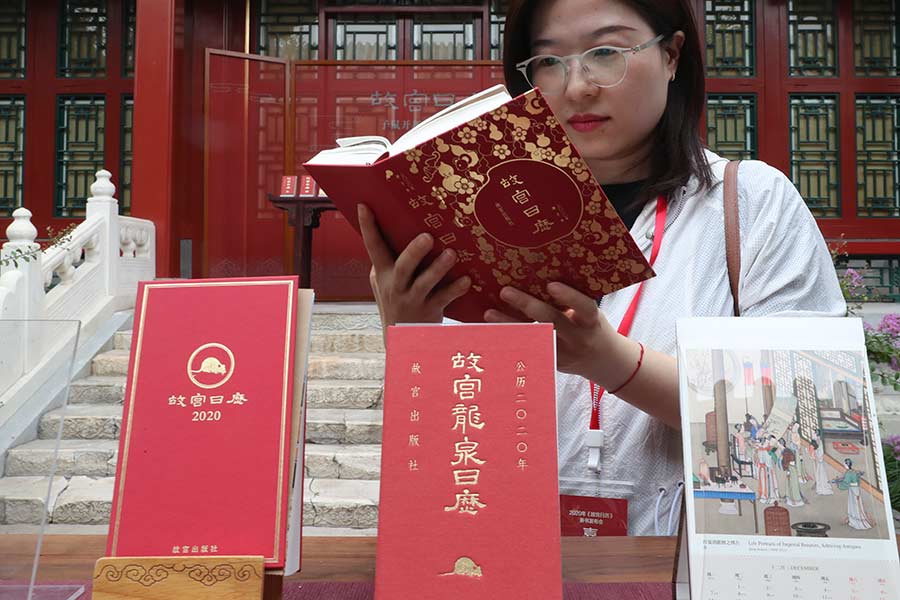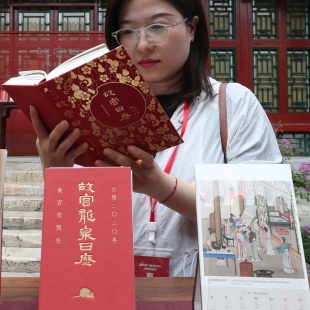Palace Museum unveils 2020 calendar


The Palace Museum, also known as the Forbidden City, welcomed the Year of the Rat a bit early by releasing its new calendar on Monday.
Next year marks the 600th anniversary of the founding of the Forbidden City, China's imperial palace from 1420 to 1911 and the world's largest wooden complex.
The calendar will also be special because 2020 is a leap year, so it will have 366 individual pages.
On each page of the calendar, published by the Forbidden City Publishing House, a collection of the museum or an area in the imperial architectural compound will be introduced through text and abundant pictures to give readers a panoramic understanding of this UNESCO World Heritage Site.
A Chinese-English bilingual version will also be released, as well as a special version with simple language for children.
"The calendar is designed to be a window for the public to appreciate the lasting charm of traditional Chinese culture and tantalizing craftsmanship," said Wang Xudong, director of the Palace Museum. "And they can enjoy it just by turning the pages every morning."
As an institution covering 720,000 square meters and housing 1.86 million cultural relics, the museum surveyed its employees to think of ways to promote its "treasures" to the general public.
"We want to wake up the sleeping cultural legacies in our museum to more people," Wang said.
The Chinese zodiac has been used as a key theme in the calendar each year.
"Rats are seen as symbols of agility, wisdom and prosperity in these cultural relics," said Chen Lihua, editor-in-chief of the calendar.
What makes the new calendar different from usual years is that it provides an encyclopedic guide to the compound, including some areas temporarily closed to the public.
"I've been working in the Forbidden City for 33 years, and I thought I was quite familiar with this place," Chen said.
"But when we began to dig out behind-the-scenes stories to build up a multidimensional image of ancient China's hub of imperial power, it felt like I got to know it again," she said.
Chen added that such a calendar connects people's fragmented knowledge of the Palace Museum into a larger, more-integrated picture.
For the Forbidden City, publishing calendars is not a new idea.
Wang said the staff once tried it decades ago to make the Forbidden City more approachable to the public. The compound where 24 emperors from the Ming (1368-1644) and Qing (1644-1911) dynasties once lived became no longer "forbidden" after being named a national museum in 1925.
Between 1933 and 1937, the museum released calendars, but the project was halted after Beijing was occupied by the Japanese during the War of Resistance Against Japanese Aggression (1931-45).
This practice had almost been forgotten until Zheng Xinmiao, director of the museum from 2002 to 2012, happened across some old calendars.
The tradition was resumed in 2009, using a format identical to that used in 1937. The unexpected popularity of the annual revival provided museum staff greater confidence for creativity. Since 2010, a new version of calendars has been released annually and over 3 million have been sold since 2009, according to the museum.
As people's lives get more digitized, paper calendars have largely lost their functionality. Nevertheless, the museum seems to have led to a revival.
"People's nostalgia for recording time and their pursuit of beauty will never waver," Chen said.
Nie Zhenning, chairman of Taofen Foundation, a charitable organization, said there were only four kinds of thematic calendar books in 2012 nationwide. But the number rocketed to over 200 in 2018, spanning natural science, fine arts, health and more.
"The Palace Museum calendar has created a unique genre in China's publishing industry," Nie said.





































